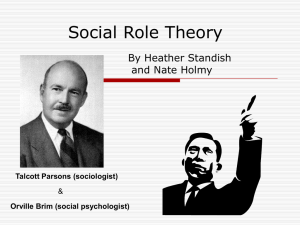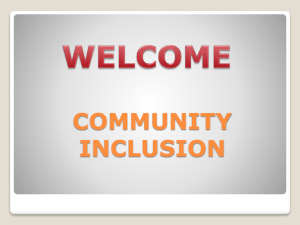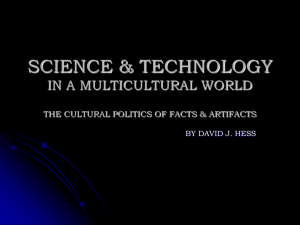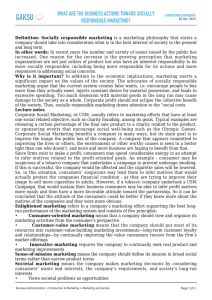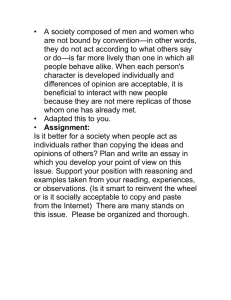Proceedings of 8th Asia-Pacific Business Research Conference
advertisement
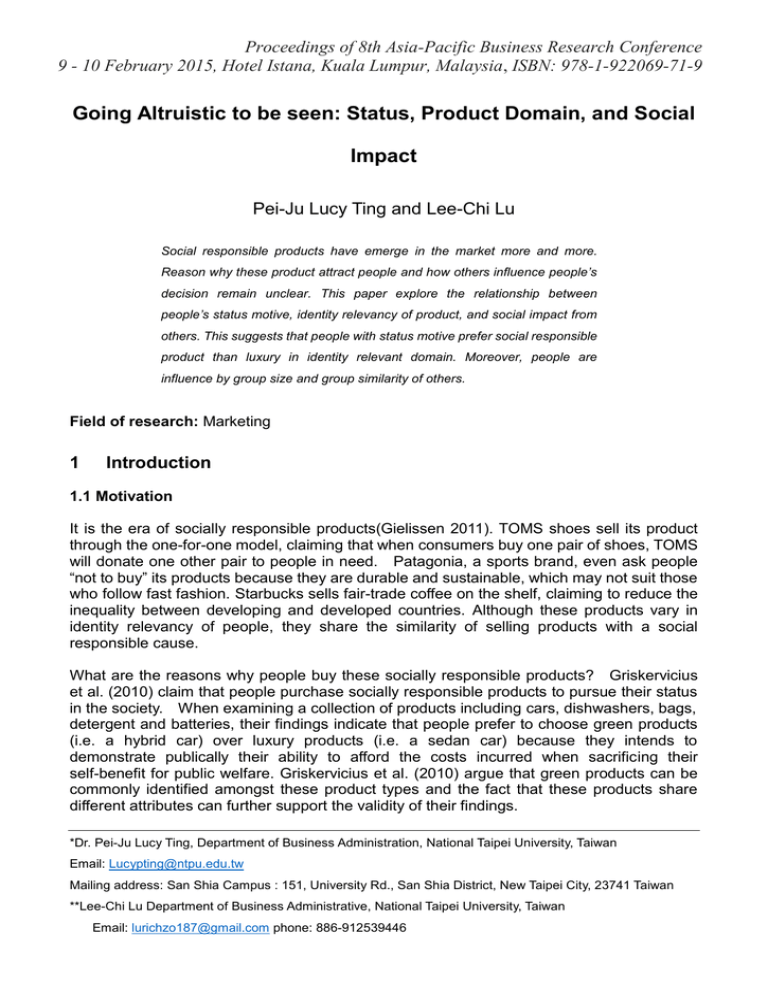
Proceedings of 8th Asia-Pacific Business Research Conference 9 - 10 February 2015, Hotel Istana, Kuala Lumpur, Malaysia, ISBN: 978-1-922069-71-9 Going Altruistic to be seen: Status, Product Domain, and Social Impact Pei-Ju Lucy Ting and Lee-Chi Lu Social responsible products have emerge in the market more and more. Reason why these product attract people and how others influence people’s decision remain unclear. This paper explore the relationship between people’s status motive, identity relevancy of product, and social impact from others. This suggests that people with status motive prefer social responsible product than luxury in identity relevant domain. Moreover, people are influence by group size and group similarity of others. Field of research: Marketing 1 Introduction 1.1 Motivation It is the era of socially responsible products(Gielissen 2011). TOMS shoes sell its product through the one-for-one model, claiming that when consumers buy one pair of shoes, TOMS will donate one other pair to people in need. Patagonia, a sports brand, even ask people “not to buy” its products because they are durable and sustainable, which may not suit those who follow fast fashion. Starbucks sells fair-trade coffee on the shelf, claiming to reduce the inequality between developing and developed countries. Although these products vary in identity relevancy of people, they share the similarity of selling products with a social responsible cause. What are the reasons why people buy these socially responsible products? Griskervicius et al. (2010) claim that people purchase socially responsible products to pursue their status in the society. When examining a collection of products including cars, dishwashers, bags, detergent and batteries, their findings indicate that people prefer to choose green products (i.e. a hybrid car) over luxury products (i.e. a sedan car) because they intends to demonstrate publically their ability to afford the costs incurred when sacrificing their self-benefit for public welfare. Griskervicius et al. (2010) argue that green products can be commonly identified amongst these product types and the fact that these products share different attributes can further support the validity of their findings. *Dr. Pei-Ju Lucy Ting, Department of Business Administration, National Taipei University, Taiwan Email: Lucypting@ntpu.edu.tw Mailing address: San Shia Campus : 151, University Rd., San Shia District, New Taipei City, 23741 Taiwan **Lee-Chi Lu Department of Business Administrative, National Taipei University, Taiwan Email: lurichzo187@gmail.com phone: 886-912539446 Proceedings of 8th Asia-Pacific Business Research Conference 9 - 10 February 2015, Hotel Istana, Kuala Lumpur, Malaysia, ISBN: 978-1-922069-71-9 However, in different product domain people diverge. Consistent with previous research, consumers are more likely to diverge from majorities, or members of other social groups, in product domains that are seen as symbolic of identity (e.g., music or hairstyles, rather than backpacks or stereos). (Berger and Heath 2007). Here we are interested in how the preference of people with status motive to social responsible products vary in different types of product. According to identity signaling theory, people purchase socially responsible product may signal their morality. Through signaling good deeds, people may acquire prestigious so that they can gain their status in group. In previous research, group size and group similarity influence people’s decision. Here we are exploring how social impact of group influence people with status. Therefore, this research is aiming at exploring how people with status motives make their purchase decision considering social impact from others in different identity relevant product domain. Specifically the objectives of this research are to explore: 1. How do consumers’ preference to social responsible product vary in identity-related product when they pursue status? 2. How group size of other people influence consumers’ attitude to social responsible product in different identity relevant product domain when they pursue status? 3. How is the social impact of similarity of other people on consumers’ attitude to social responsible product in different identity relevant product domain when they pursue status? 1.2 Contribution of this research In identity relevant product domain, if people with status prefer socialyl responsible products to luxury, this indicates that people signal their prosocial or moral identity to others to enhance their status in group. Thus marketers should focus on stimulating people’s status through marketing skills. In identity irrelevant product domain, if people with status prefer luxury to socially responsible product, it is inferred that the influence of status become smaller. In this way marketers should consider other marketing skills to differentiate their socially responsible product. If people with status prefer socially responsible product because majority people choose luxury, this means they want to signal their moral identity to gain status. Thus marketers should keep socially responsible product in niche market to maintain the image of social responsible product among consumers. Moreover, Moreover, if people with status prefer socially responsible products to luxury due to similar others, this reminds marketers of the importance of group membership. Proceedings of 8th Asia-Pacific Business Research Conference 9 - 10 February 2015, Hotel Istana, Kuala Lumpur, Malaysia, ISBN: 978-1-922069-71-9 2 Literature Review and hypothesis 2.1 Altruism and status Altruism by definition benefits others at the cost of depleting the giver’s resources needed for survival, reproduction, or kin care (Barrett, Dunbar et al. 2002). While a rational economic perspective considers altruism to be a theoretical “anomaly” (Dawes and Thaler 1988) and the existence of altruism is similarly puzzling from an evolutionary, gene selection perspective (Dawkins and Krebs 1978), two theories explain the prevalence of altruism, competitive altruism and cost signaling theory. 2.1.1 Competitive altruism Individuals across diverse cultures and historical periods are known to compete for status by trying to be seen as relatively more altruistic—a concept known as competitive altruism. the person who is able to give away the most resources is regarded as the highest standing member in the group (Lockhart and Murdock 1970). From the conspicuously large donations made by modern day tycoons such as Ted Turner or Bill Gates, to the sponsorship of trans-Atlantic voyages and opulent operas by European royals, and to the desire to be the nicest dinner-party hostess, competitive altruism perforates across historical and contemporary cultures (Schultz, Nolan et al. 2007). 2.1.2 Cost signaling theory According to a costly signaling perspective, an altruistic act is a communicative signal. This signal, however, communicates more than a person’s prosociality; altruism can also signal an individual’s ability to incur costs (BliegeBird, Smith et al. 2005).That is, in addition to signaling that a person is prosocial, altruism can simultaneously signal that one has sufficient time, energy, money, or other valuable resources to be able to afford to give away such resources without a negative impact on fitness. Thus, from a costly signaling perspective, incidents of public self-sacrifice are associated with status because such acts demonstrate both one’s willingness and one’s ability to incur the costs of self-sacrifice for public welfare. 2.1.3 Relationship between status and prosocial behavior While people compete for status through altruistic behavior according to competitive altruism, people behave altruistically, which also mean self-sacrifice, to signal they have the ability to Proceedings of 8th Asia-Pacific Business Research Conference 9 - 10 February 2015, Hotel Istana, Kuala Lumpur, Malaysia, ISBN: 978-1-922069-71-9 incur the cost due to cost signaling theory. This confirm the relationship between status and prosocial behavior. Therefore, people might engage in costly prosocial behaviors such as environmental conservation particularly when they are motivated to attain status. In other words, activating a motive for status might lead people to prefer conspicuous prosocial conservation to luxury. (Griskevicius, Tybur et al. 2010) 2.2 Diverge and product domain 2.2.1 People’s taste and identity People’s tastes—the products they buy, attitudes they profess, and preferences they hold—can act as signals of identity, communicating useful information to others (Hauser and Wernerfelt 1990). People buy products for not only what they do but also what they symbolize (Levy 1959). Consumers use products to construct and express desired identities (Escalas and Bettman 2005), and people infer aspects about others (e.g., identities and other preferences) based on their purchase decisions (Calder and Burnkrant 1977); for overviews, see(Belk, Bahn et al. 1982). 2.2.2 Identity relevancy and product domain While any product could theoretically be used to infer identity, people seem to use certain types of taste domains more than others (Belk, Bahn et al. 1982). For example, when students were asked to select cues that would aid in making inferences about other students, most selected either clothing or academic courses (Burroughs, Drews et al. 1991). Some products are more easily able to communicate things about their users (Escalas and Bettman 2005), and research on attitude functions contrasts symbolic products (e.g., a school sweatshirt) with those that are more instrumental (e.g., a stereo [Shavitt 1990]; see also Katz 1960). Compared to more utilitarian products, when people were asked to describe the type of person who uses a given product, identity-relevant products elicited more dispositional information about another person (Shavitt and Nelson 1999). Thus, people seem to be more likely to make identity inferences about others when taste domains are seen as symbolic of identity. Consumers often make choices that diverge from those of others to ensure that they effectively communicate desired identities. In identity domains, participants avoided options preferred by majorities and abandoned preferences shared with majorities. Proceedings of 8th Asia-Pacific Business Research Conference 9 - 10 February 2015, Hotel Istana, Kuala Lumpur, Malaysia, ISBN: 978-1-922069-71-9 People use symbolic domains to make identity inferences about others, but the particular identities that are inferred depend on who else holds the taste. Consequently, who else holds the taste—both the size of the group of taste holders and the social group to which they belong—will have a greater influence on divergence in domains that others use to infer identity. (Berger and Heath 2007) Hypothesis H1a: People with status motives prefer socially responsible product than luxury in identity relevant product domain. H1b: Socially responsible product and luxury are equally attractive to people with status motives in identity irrelevant product domain. H2a: When the socially responsible product preferred by majority, people with status motives prefer socially responsible product in identity relevant domain. H2b: When the socially responsible product preferred by minority, people with status motives equally evaluate social responsible product and luxury. H3a: When the socially responsible product owner is ingroup member, people with status motives prefer social responsible product in identity relevant domain. H3b: When the socially responsible product owner is outgroup member, people with status motives equally evaluate socially responsible product and luxury. 3. Methodology Three studies examined how product domain, status, group size, and group similarity influence consumers’ preference. Study1 focus on whether identity relevancy of product interact with status motives. Study2 examines whether group size interact with status and Proceedings of 8th Asia-Pacific Business Research Conference 9 - 10 February 2015, Hotel Istana, Kuala Lumpur, Malaysia, ISBN: 978-1-922069-71-9 product domain. Study3 examines whether group similarity interact with status and product domain. Study1 Participants Three hundred respondents complete the survey in National Taipei University. The respondents are separated into four groups in different classrooms. Design and procedure Participants are shown 20 different products, and then choose options A(65% people prefer this type), B(25% people prefer this type), C(10% people prefer this type) toward each product. Participants answer their opinion about the relationship between product and identity of people. As a result, identity relevant products and identity irrelevant products are confirm. Next step the participants read short story of status condition and control condition. They are told to imagine they are out shopping in a store. They are required to choose product with characteristic of either social responsibility or luxury and either owned by majority or minority. Pretest of identity relevant product Selecting Twenty respondents choose either option preferred by 65% of others, 25%of others, or 10% of others toward twenty different product, including motorcycle, tote, car brand, sunglasses, bike light, backpack, jacket, detergent, sofa, CD, shoes, magazines, coffee beans, toothpaste, stereo, power tool, dish soap, stereo, plate, and lamp. This three option structure allow us to separate identity signaling from majority avoidance. If people choose option of 10% preferred by others, it indicates that they want to communicate their identity through the product. Also, separated group are asked to rate the same product domain either on self-expression (“how much it contributes to self-expression-i.e., a person’s ability to express their identity”, N=20) or identity inference making (“how much people use it to make inference about others- i.e., people think they know a lot about a person based on their choice in this domain”; N=20). Consisting with identity signaling perspective, the rating of self-expression and identity inference making were highly correlated, so we averaged them to form an index of domain relevance. We also test the degree of consensus in each domain to ensure Proceedings of 8th Asia-Pacific Business Research Conference 9 - 10 February 2015, Hotel Istana, Kuala Lumpur, Malaysia, ISBN: 978-1-922069-71-9 individuals’ agreement about identity relevancy of product. Finally, we choose two of the most identity relevant product and two of the least identity relevant product. Motive primes To elicit status motives, participants read a short story of about 700 words that has been used successfully to elicit status motives in previous research (see Griskevicius, Tybur, et al., 2009). In the story, participants imagine graduating from college, looking for a job, and deciding to go work for a large company because it offers the greatest chance of moving up. The story describes the person’s first day on the job, focusing on the high-status features of the workplace such as the upscale lobby and nice furniture. Readers eventually learn that they will have an opportunity to receive a desirable promotion. The story ends as the reader ponders moving up in status relative to his or her same-sex peers. In the control condition, participants read a story of similar length designed to elicit similar levels of affect as the status story. Specifically, participants read about losing a ticket to an upcoming concert and searching for the ticket throughout the house. After the person finds the ticket, he or she heads off to the concert with a same-sex peer (see Griskevicius, Cialdini, & Kenrick, 2006; Griskevicius, Goldstein, Mortensen, Cialdini, & Kenrick, 2006). The control and status stories were carefully matched to include interactions with same-sex peers. Extensive pilot testing of this manipulation (reported in Griskevicius, Tybur, et al., 2009) has to confirm that relative to the control story, the status story elicits a “desire for social status” and a “desire for prestige”. Compared to the control story, the status story also elicited relatively similar levels of negative affect and positive affect. Importantly, the status story did not mention what the company does or what types of tactics might be useful in gaining status or getting the promotion, meaning that the status manipulation made no mention of cooperation, helping, self-sacrifice, or prosocial behavior. Product After the motive manipulation, participants proceeded to the next part of the study. Participants were asked to consider that they were out shopping for four products: (a) a scooter, (b) a tote, (c) a detergent, and (d) plate. These products were chosen for the study Proceedings of 8th Asia-Pacific Business Research Conference 9 - 10 February 2015, Hotel Istana, Kuala Lumpur, Malaysia, ISBN: 978-1-922069-71-9 because they are tested in identity relevant selecting section and plus they all are currently available in a prosocial and a conventional form, and each type of product is prosocial in a slightly different manner (e.g., low CO2 emissions, international aid and development, recyclability and sustainability, and nontoxic, respectively). Specifically, scooter and tote are in the domain of more identity relevant product while bowl and coffee filter are in the domain of identity less relevant product. For each of the four types of products, participants were presented with a choice: the more luxurious non-prosocial option or the socially responsible option. For each choice, the two products were equal in price, were manufactured by the same company, and were accompanied by three features that described key aspects of each product. Importantly, the non-prosocial product was superior on dimensions of luxury and performance, whereas the social responsible product was superior on the prosocial dimension. Because we predicted that status motives should lead people to want to be seen as more prosocial, it was important that all four socially responsible products were perceived as being associated with more prosociality than their non-prosocial counterparts. We thus pretest the perceptions of the six products with a group of 20 participants. These participants saw both the socially responsible products and the socially responsible products accompanied with their complete descriptions (see appendix). These products are arranged in random order. For each of the products, participants indicated on a 1–9 scale the extent to which the person who owned this product was (a) nice, (b) caring, and (c) altruistic. In the current experiment, the four types of products were presented in random order. Participants were asked the following two-option question: “If you were out shopping for a scooter/tote/plate/detergent, which of these two products would you buy?” Because in previous research status motive did not interact with participants’ gender for the these products (Griskevicius, Tybur et al. 2010), the analysis are collapsed with participants’ gender. Study2 Participants One hundred respondents complete the survey in National Taipei University. The respondents are separated into four groups in different classrooms. Proceedings of 8th Asia-Pacific Business Research Conference 9 - 10 February 2015, Hotel Istana, Kuala Lumpur, Malaysia, ISBN: 978-1-922069-71-9 Procedure Participants are divided into two condition, status condition and control condition. The priming process of condition follow the process in study1. In each condition, participants are asked to complete a “New Product Testing” survey. Participants are told that this survey is interested in your attitude to new products. Two products are chosen in the study1, including characteristics of both identity relevancy and socially responsibility concerns. Participants are given both general product description (social responsibility concerns or luxury-related words) as well as “results of some recent focus group testing”. Conditions differ in the description of the group size of experimenter. Specifically, people in majority condition read” 77% of experimenters reported that they could see themselves using this product” and “69% of the experimenters suggested that this product fit what they need” while people in majority condition read” only23 % of experimenters reported that they could see themselves using this product” and “only 31% of the experimenters suggested that this product fit what they need”. Participants then complete the preference test between socially responsible product and luxury in two different product domain. Study3 Participants One hundred respondents complete the survey in National Taipei University. The respondents are separated into four groups in different classrooms. Procedure Participants are divided into two condition, status condition and control condition. The priming process of condition follow the process in study1. In each condition, participants are asked to complete a “New Product Testing” survey. Participants are told that this survey is interested in your attitude to new products. Two products are chosen in the study1, including characteristics of both identity relevancy and socially responsibility concerns. Participants are given both general product description (socially responsibility concerns or luxury-related words) as well as “results of some recent Proceedings of 8th Asia-Pacific Business Research Conference 9 - 10 February 2015, Hotel Istana, Kuala Lumpur, Malaysia, ISBN: 978-1-922069-71-9 focus group testing”. Conditions differ in the description of the group similarity of experimenter. Specifically, people in majority condition are told this survey was conducted among a group of individuals (25-34-year-old business executives). Then they read” 77% of experimenters reported that they could see themselves using this product” and “69% of the experimenters suggested that this product fit what they need”. On the other hand, people in majority condition are told this survey was conducted among a group of individuals (65-74-year-old retired public government executives). Then they read” 77 % of experimenters reported that they could see themselves using this product” and “69 % of the experimenters suggested that this product fit what they need”. Business executives (25-34 years old) are chosen as similar in-group consisting with story of motive priming while retired government executives (65-74 years old) are chosen as dissimilar out-group. Participants then complete the preference test between socially responsible product and luxury in two different product domain. Reference Barrett, L., et al. (2002). Human evolutionary psychology, Princeton University Press. Belk, R. W., et al. (1982). "Developmental recognition of consumption symbolism." Journal of Consumer Research: 4-17. Berger, J. and C. Heath (2007). "Where consumers diverge from others: Identity signaling and product domains." Journal of Consumer Research 34(2): 121-134. BliegeBird, R., et al. (2005). "Signaling theory, strategic interaction, and symbolic capital 1." Current Anthropology 46(2): 221-248. Burroughs, W. J., et al. (1991). "Predicting personality from personal possessions: A self-presentational analysis." Journal of Social Behavior & Personality. Calder, B. J. and R. E. Burnkrant (1977). "Interpersonal influence on consumer behavior: an attribution theory approach." Journal of Consumer Research: 29-38. Dawes, R. M. and R. H. Thaler (1988). "Anomalies: cooperation." The Journal of Economic Perspectives: 187-197. Proceedings of 8th Asia-Pacific Business Research Conference 9 - 10 February 2015, Hotel Istana, Kuala Lumpur, Malaysia, ISBN: 978-1-922069-71-9 Dawkins, R. and J. R. Krebs (1978). "Animal signals: information or manipulation." Behavioural ecology: An evolutionary approach 2: 282-309. Escalas, J. E. and J. R. Bettman (2005). "Self‐construal, reference groups, and brand meaning." Journal of Consumer Research 32(3): 378-389. Gielissen, R. (2011). "Why do consumer’s buy socially responsible products." International Journal of Business and Social Science 2(3): 21-35. Griskevicius, V., et al. (2010). "Going green to be seen: status, reputation, and conspicuous conservation." Journal of personality and social psychology 98(3): 392. Hauser, J. R. and B. Wernerfelt (1990). "An evaluation cost model of consideration sets." Journal of Consumer Research: 393-408. Lockhart, R. S. and B. B. Murdock (1970). "Memory and the theory of signal detection." Psychological Bulletin 74(2): 100. Schultz, P. W., et al. (2007). "The constructive, destructive, and reconstructive power of social norms." Psychological science 18(5): 429-434. Shavitt, S. and M. R. Nelson (1999). "The social identity function in person perception: Communicated meanings of product preferences." Why we evaluate: Function of attitudes: 27-57.
